Birdtours2Asia
Expert guided birding tours
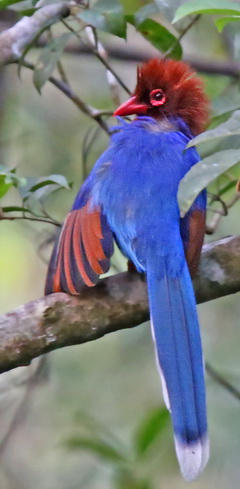
Yet another colourful day thanks to this
Sri Lanka Blue Magpie!
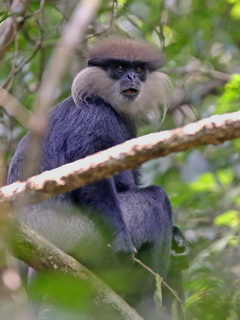
The park is a good place for wildlife and even has a few
Elephant and Leopard. More visible for us visitors are the
Purple-faced Leaf Monkeys. They remain quite common
in the park even though this endemic
species is listed as endangered on the
IUCN Red List of threatened species.
B2A
Join us on a tour and you'll get
Top-quality holidays
Friendly & experienced leaders
Excellent itineraries & trip logistics
Comfortable high quality
accommodations
All inclusive competitive tour prices
Small groups - size limit=6
Finest birding in Asia
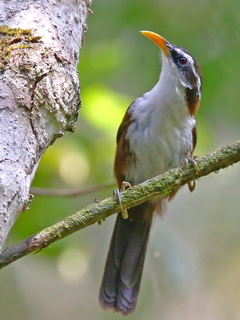
This is one of the 'newer' endemics (splits)
Sri Lanka Scimitar Babbler
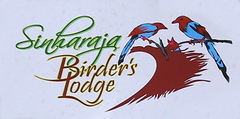
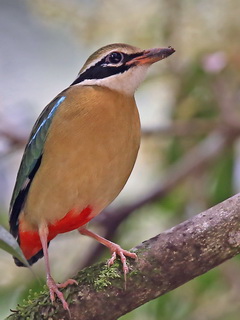
Just 1 more reason to visit Sri Lanka
in winter; Indian Pitta

I won't easily run out of endemics on this page; Ashy-headed
Laughingthrush

Always a top-favourite, and taking
lots of vertical space on the web ;-)
The Indian Paradise Flycatcher

We power your vacation
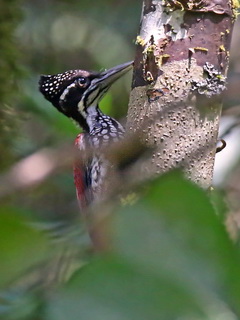
Greater Sri Lanka Flameback, female.
Another common name for this
Woodpecker is Crimson-backed Flameback.
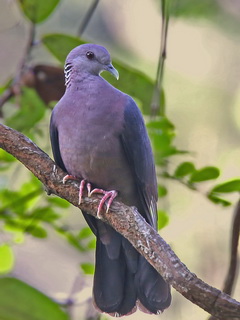
Lucky shot! This Ceylon Woodpigeon is
scarce and not usually easy to get in front
of the lens. All I had to do this time is
jump out of the car. The park boundary
has excellent birding as well. In fact,
roadside birding anywhere in the
country can be refreshingly good.
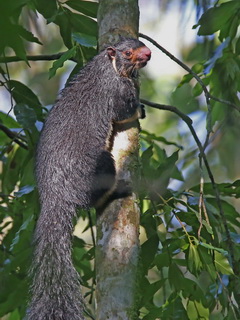
Grizzled Giant Squirrel
At Sinharaja these are from the
melanochra subspecies. It otherwise
occurs through most of Sri Lanka and
a few locations in southern India.
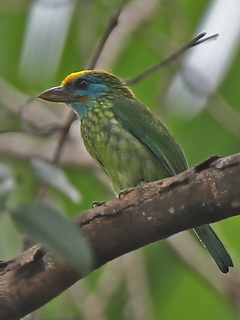
The endemic Yellow-fronted Barbet
isn't too scarce but I didn't think they
were easy to see let alone photograph.
This is a rather distant shot that received
lots of cropping, light adjustment and sharpening.

The Sri Lanka Drongo has a restricted
range as it is only found in virgin
rainforest of the wet zone.
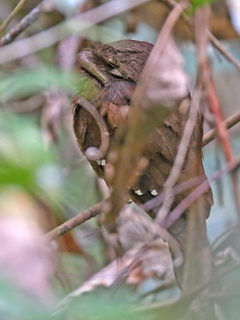
I didn't get the female Sri Lanka
Frogmouth too well as it was perched
inside dense tangles.

This Orange-billed Babbler is quite
common at Sinharaja. Unlike its
Yellow-billed cousin this bird, (also called Ceylon Rufous
Babbler) is another
range-restricted species only
found in SW Sri Lanka.
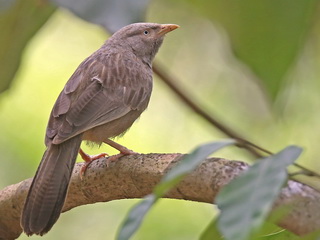
The Yellow-billed Babbler may be found
only in peninsular India, or just about
anywhere in Sri Lanka. Sure enough it
wasn't missing from the garden of the accommodation at
Sinharaja.

Slow effortless wing beats, this must
be the Ceylon Tree Nymp! Males do collect
danaidone from various plants, which is a poisonous chemical
making the butterfly unpalatable to predators. The chemical is
passed to the female during mating and
will also end up in her eggs.

The White-bellied Drongo indeed is
'white-bellied' in India and the rest
of Sri Lanka. This is race leucopygialis
which does occur in SW Sri Lanka; yes
at Sinharaja. Sometimes more aptly
named White-vented Drongo.
Sinharaja is one of the most rewarding
and enjoyable birding sites in Asia.
During my two full days in the field I
was keen to snap along any photo opportunity. However, this
was relaxed birding and certainly not hunting for
photos. No chasing, no sound recordings,
no bird food, no hides were used.
The reason I got 21 out of 28 endemic
birds on photo in such a short time must
lie with the excellence of the birding site.
I used the 150-600mm lens from
Tamron mounted on the cheapest
available full-frame DSLR body.
These are both good and reasonable
priced but I would not really call it professional gear.
I mean, you too can do this!
All you may need is a little field-craft
and a
holiday to Sri Lanka! Cheers!
Hope you enjoyed the set. -Stijn-
Sinharaja,
20 - 22 February 2017.
Sri Lanka's celebrated Biosphere Reserve and World Heritage
Site; A photo report.
On this page I would like to showcase the riches of
Sinharaja National Park. You may find a selection of
opportunity shots made on the afternoon of 20th, a full day
and the morning of 22nd Feb. '17. Focus was on the birds of
course but I hope the good number of material obtained in
such a short time may make us realize what an incredible
biodiversity hotspot Sinaraja is. My short two days of
birding here was part of a longer trip that also included
visits to Yala NP and Tissamahama area in Sri Lanka's dry
zone. The time of year was rather perfect. This is after the
'high' tourist season, with just about the best chance in
the year on dry weather, and all wintering birds still
present. Birding was done on the main track into the park
and a couple sites on the parks boundary. The grounds and
vicinity of the accommodation (comfortable air-con rooms and
excellent authentic food) held good birds as well;
Slaty-legged Crake, Indian Pitta, Sri Lanka Hill Myna...
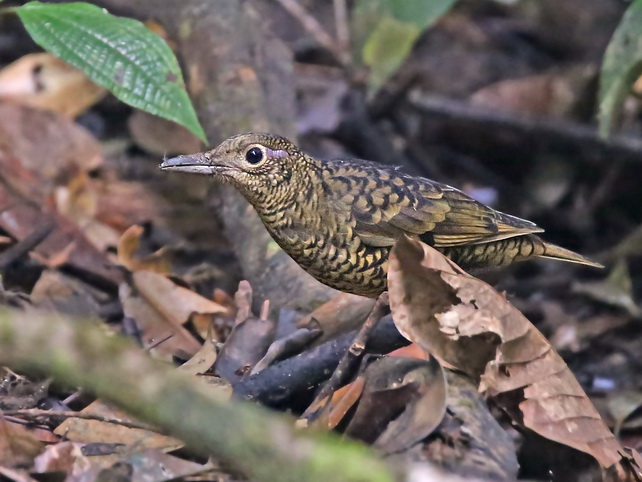 The Sri Lanka Scaly Thrush is
often regarded as 1 of the more difficult to find
endemics. With only 1 sighting
The Sri Lanka Scaly Thrush is
often regarded as 1 of the more difficult to find
endemics. With only 1 sighting
it didn't appear common but once found our bird was quite
cooperative and we watched it for at least
15 minutes while it kept foraging in the leaf litter.
Undisturbed as the bird was I think it only looked up
and into the lens once so I'm pretty happy I was able to
capture the moment.
This is 1 of only few endemic birds listed as threatened
in Sri Lanka. As with so many places on earth
habitat loss is a problem. However, in Sri Lanka birds are
very well protected inside the reserves.
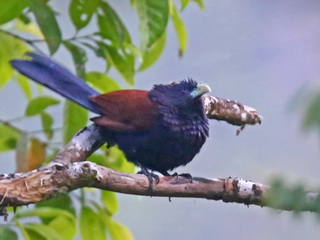
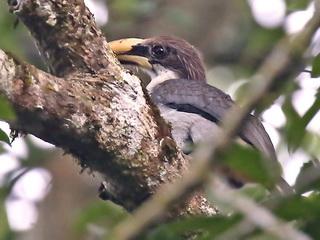 Green-billed
CoucalSri Lanka
Grey Hornbill
Posted just above are two more
fine Sri Lankan endemics. Most species featuring "Sri
Lanka" in their
Green-billed
CoucalSri Lanka
Grey Hornbill
Posted just above are two more
fine Sri Lankan endemics. Most species featuring "Sri
Lanka" in their
name may alternatively retain "Ceylon", the former naming
of the island. (Ceylon Grey Hornbill.)
Out of 34 Sri Lankan endemic birds (IOC world bird names),
no less than 28 may be found at Sinharaja!!
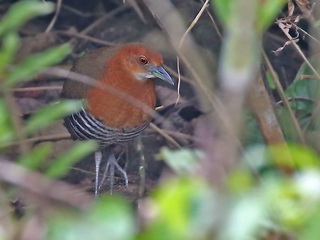
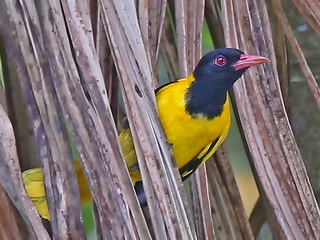 Let us take a little break
from the endemic bonanza. And from the forest perhaps?
Time to post a few photos taken in the grounds of the Blue
Magpie Lodge. The Slaty-legged Crake is a scarce winter
visitor to most of South and South-east Asia. It is really
amazing how we found this elusive Crake simply in the
garden of the lodge. With the Black-hooded Oriole it got
even better, this shot was taken from the lunch table!!
Let us take a little break
from the endemic bonanza. And from the forest perhaps?
Time to post a few photos taken in the grounds of the Blue
Magpie Lodge. The Slaty-legged Crake is a scarce winter
visitor to most of South and South-east Asia. It is really
amazing how we found this elusive Crake simply in the
garden of the lodge. With the Black-hooded Oriole it got
even better, this shot was taken from the lunch table!!
 This Green Vine Snake was
found along the main track in the National Park.
This Green Vine Snake was
found along the main track in the National Park.
Harmless and super beautiful, these pencil size creatures
are easily overlooked!

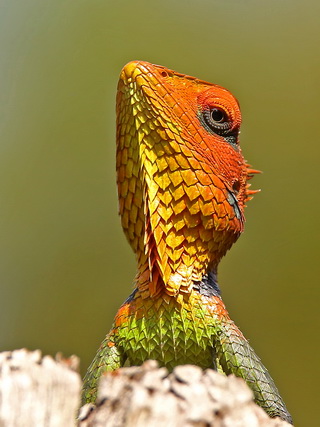 This misty morning image shows
some tea plantation mixing in with forest at the park's
boundary.
This misty morning image shows
some tea plantation mixing in with forest at the park's
boundary.
The Common Green Forest Lizard is all green indeed, except
for when in high breeding mood!!
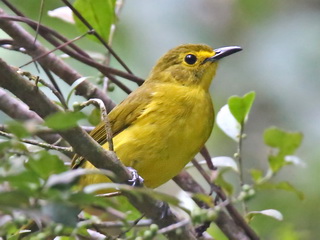
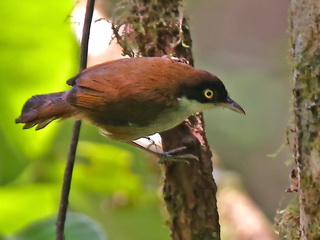 Two cute forest birds. The
Yellow-browed Bulbul and the Dark-fronted Babbler
Two cute forest birds. The
Yellow-browed Bulbul and the Dark-fronted Babbler
may not be too easy to photograph but they are not scarce
inside good forest at Sinharaja.
Together with quite a few other species they are excellent
candidates to be added to
your life list on a Sri Lanka visit, that is unless you
have been to peninsular India previous.
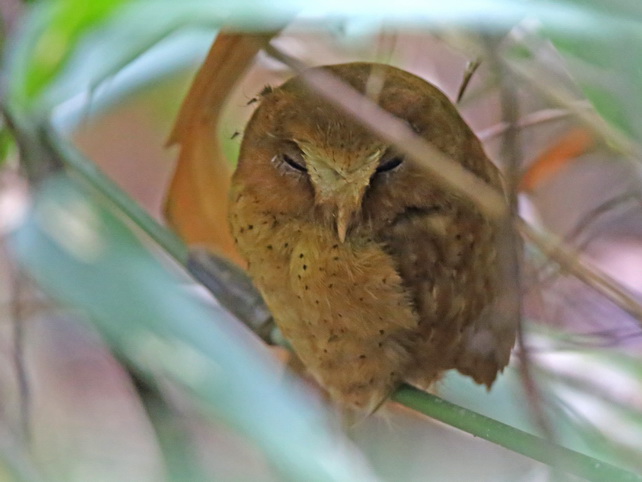 If ever you would have been
looking for a reason to visit a place again... this must
be a proper case! I did not see the Serendib Scops Owl on
my first Sri Lanka visit! Because it simply wasn't
discovered yet (and I wasn't the one finding it first ha
ha). Back in 2000 nobody knew about this owl while it was
present in a well birded location. Today it features on
most trip lists. As in this case it is not unlikely to be
rewarded with a daytime sighting even though they may not
roost in exactly the same spot every day.
If ever you would have been
looking for a reason to visit a place again... this must
be a proper case! I did not see the Serendib Scops Owl on
my first Sri Lanka visit! Because it simply wasn't
discovered yet (and I wasn't the one finding it first ha
ha). Back in 2000 nobody knew about this owl while it was
present in a well birded location. Today it features on
most trip lists. As in this case it is not unlikely to be
rewarded with a daytime sighting even though they may not
roost in exactly the same spot every day.
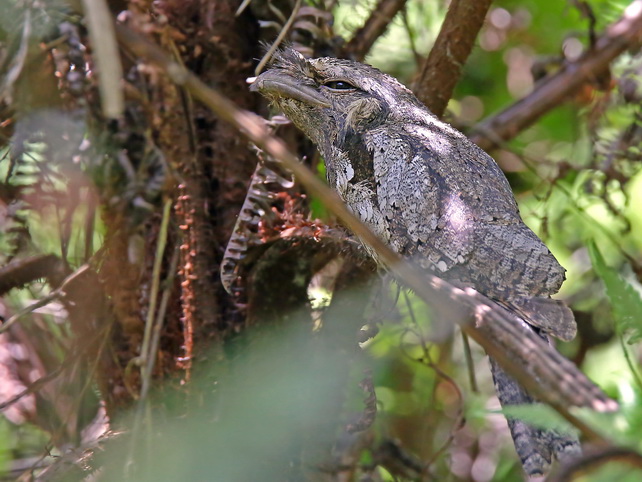 Daytime night birds do give
birders more time in the evening to celebrate the
sightings of the day :-)
Daytime night birds do give
birders more time in the evening to celebrate the
sightings of the day :-)
Sri Lanka Frogmouth, here the male, and with the female
roosting nearby, were found with relative ease.
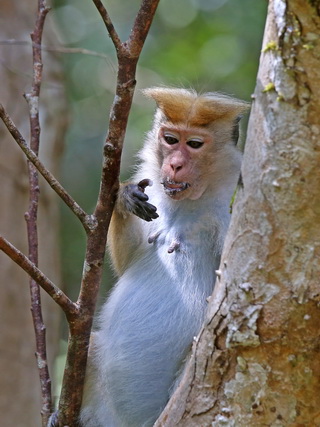
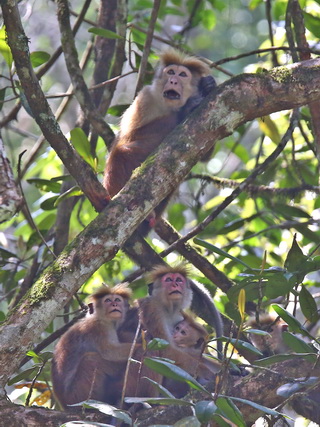 For the Toque Macaque it is
all about hairstyle, eyeliner and black lipstick... but
then Black Eagle alarm!!
For the Toque Macaque it is
all about hairstyle, eyeliner and black lipstick... but
then Black Eagle alarm!!
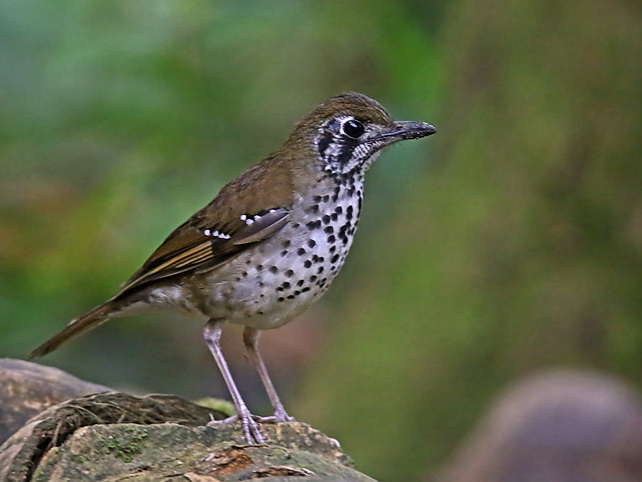 The lovely Spot-winged Thrush
is another must-see target bird. With 3 sightings it
easily added to the
The lovely Spot-winged Thrush
is another must-see target bird. With 3 sightings it
easily added to the
Sinharaja endemics tally. However only 1 individual was
friendly enough to allow for photo opportunities.

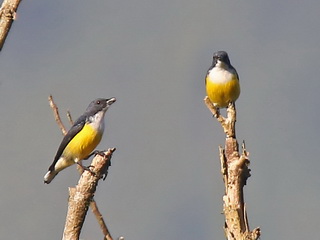 A
forested ridge at Sinharaja core area.The Legge's Flowerpecker, must
be endemic!
A
forested ridge at Sinharaja core area.The Legge's Flowerpecker, must
be endemic!
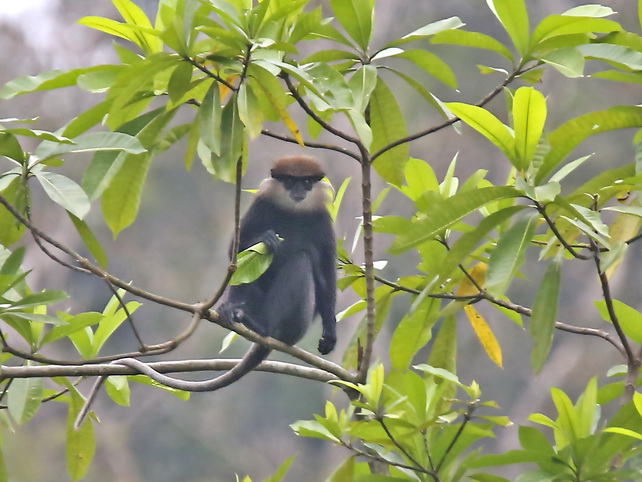 A rather distant shot of the
Purple-faced Langur! There are 4 distinct subspecies
recognized. The ones found at Sinharaja Forest Reserve are
from the race 'vetulus' or Southern Lowland Wetzone
Purple-faced Langur.
A rather distant shot of the
Purple-faced Langur! There are 4 distinct subspecies
recognized. The ones found at Sinharaja Forest Reserve are
from the race 'vetulus' or Southern Lowland Wetzone
Purple-faced Langur.

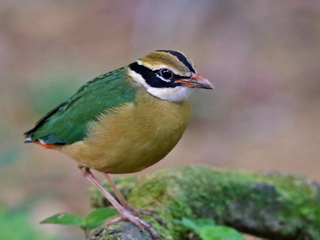 The cream of forest birds!
Trogons and Pittas always make for a happy day.
The cream of forest birds!
Trogons and Pittas always make for a happy day.
Both the Malabar Trogon and Indian Pitta may be best
(easier) seen in Sri Lanka rather than in India
where the Pitta breeds in the north, while the Trogon
occurs in peninsular India only.
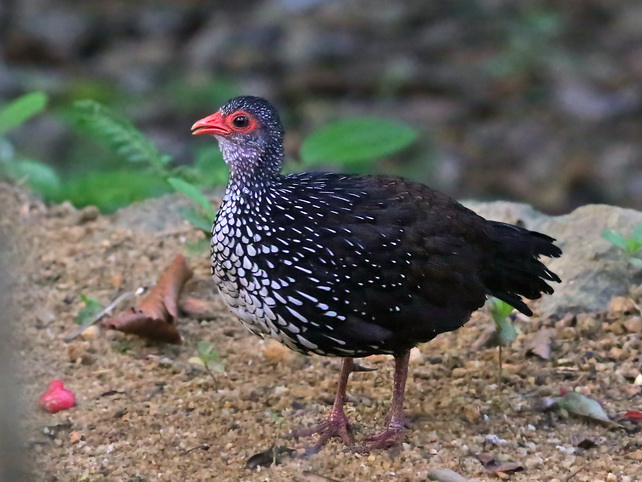 At Sinharaja, after connecting
with most of the endemics and good target birds, which
would be the 1 left to look for?? Quite possibly it would
be the Sri Lanka Spurfowl indeed. Not always easy to find,
not always
At Sinharaja, after connecting
with most of the endemics and good target birds, which
would be the 1 left to look for?? Quite possibly it would
be the Sri Lanka Spurfowl indeed. Not always easy to find,
not always
showing too well, but a little essential as Sinharaja
simply is the best site for these stunners. And there
is more, they have an incredible sound. The male bird
pictured is calling and I can tell you this is SO loud
when you are just a few meters away!! I didn't manage a
sound recording but I have embedded a
superb Xeno-Canto recording made by a friend
from Belgium in the column on the left. Try it!
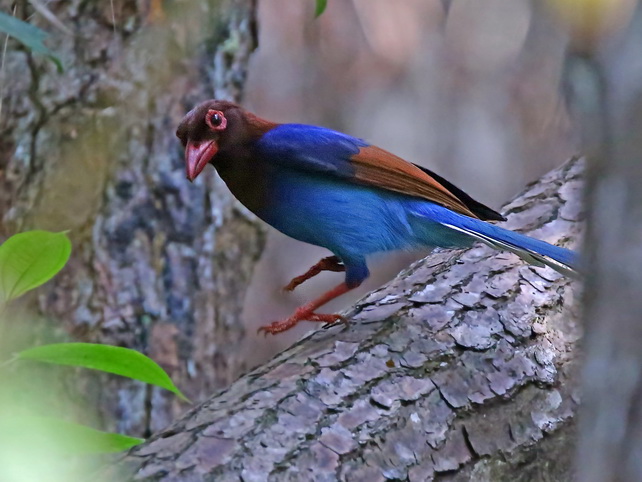 It may be less easy than it
looks from my photos to connect with the Sri lanka Blue
Magpie as they have very large foraging areas. Three
sightings isn't too bad even though they have declined
somewhat. However this doesn't mean great photo
opportunities yet and my first encounter only yielded a
record shot.
It may be less easy than it
looks from my photos to connect with the Sri lanka Blue
Magpie as they have very large foraging areas. Three
sightings isn't too bad even though they have declined
somewhat. However this doesn't mean great photo
opportunities yet and my first encounter only yielded a
record shot.
They didn't seem easy inside the park during my visit. But
at the parks boundary I got lucky twice.
First a superb pair which now features on our Sri
Lanka tour page and on my last morning I was happy
to capture this jumping Magpie action on film. This is a
restricted range endemic listed as vulnerable.
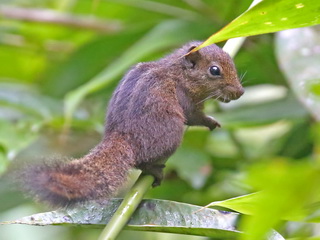
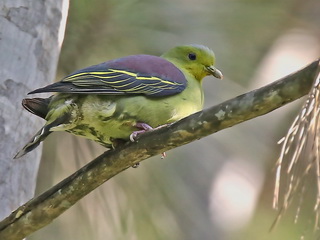 Not only the birds may be
endemics at Sinharaja. This is the Dusky Palm Squirrel,
only found in Sri Lanka
Not only the birds may be
endemics at Sinharaja. This is the Dusky Palm Squirrel,
only found in Sri Lanka
and listed as vulnerable on the IUCN Red List. On the
right is a photo of a nice male Sri Lanka Green Pigeon.
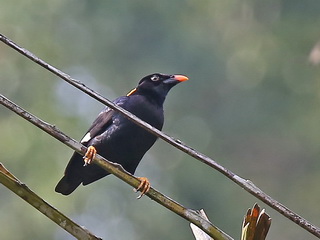
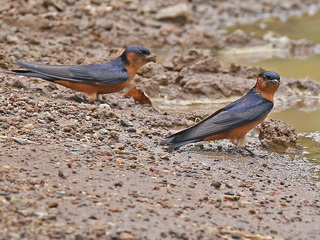 Restricted range, uncommon,
local and listed near-threatened, all doesn't look that
good for the Sri Lanka Hill Myna but luckily we have
Sinharaja Forest Reserve where the species remains common.
Restricted range, uncommon,
local and listed near-threatened, all doesn't look that
good for the Sri Lanka Hill Myna but luckily we have
Sinharaja Forest Reserve where the species remains common.
On the right are Sri Lanka Swallows busy collecting mud
for nest building.
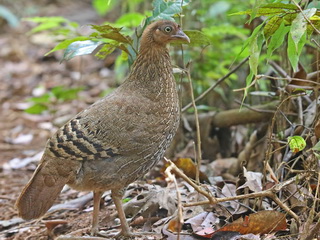
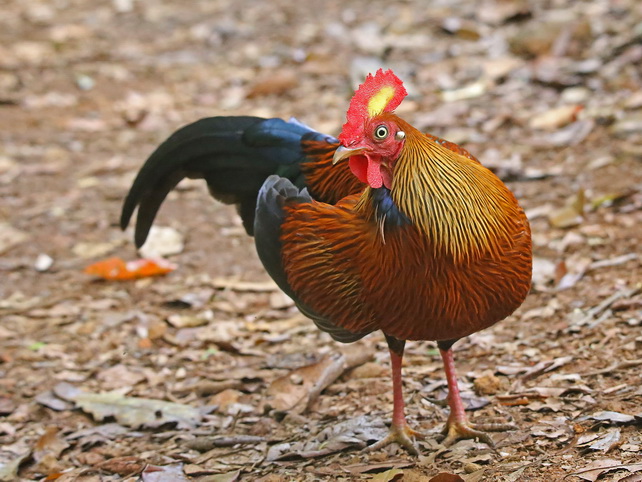 The national bird should not
be missing from this page. Mind you, Sri Lanka Junglefowl
are endemic and well protected by law. No wonder they were
easy to photograph. They also sound better than domestic
chicken!
The national bird should not
be missing from this page. Mind you, Sri Lanka Junglefowl
are endemic and well protected by law. No wonder they were
easy to photograph. They also sound better than domestic
chicken!

 Any perched Hanging Parrot
must be good! Luckily Sri Lanka Hanging Parrots remain
common and sooner
Any perched Hanging Parrot
must be good! Luckily Sri Lanka Hanging Parrots remain
common and sooner
or later a good sighting is to be expected. On the right
is the commoner of the two Flamebacks on the island. This
is the beautiful Lesser Sri Lanka Flameback and the
species occurs both in the
wet and dry zone but is absent from the northern half of
the island.
Home / Top
/ Visit
Sri Lanka
















































